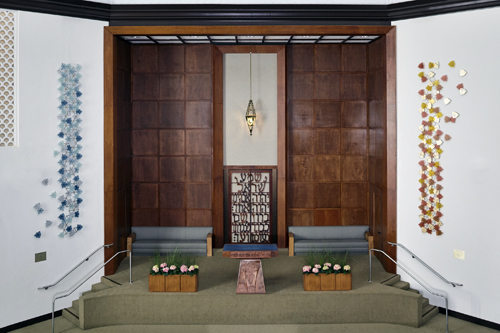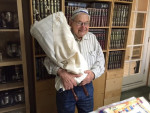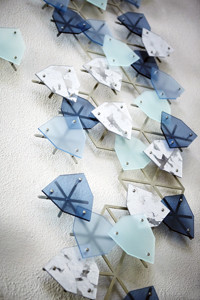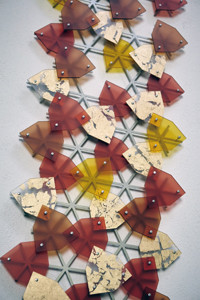
By Donald H. Harrison


SAN DIEGO — Before Holocaust Survivor Lou Dunst died last year, he and his wife Estelle commissioned art to enhance the Holy Ark at Ohr Shalom Synagogue at Third and Laurel Streets in San Diego.
Four artists competed for the honor of designing the works, with architect Amy Reichert of Chicago, who is also known for her works of Judaica, eventually chosen as the winner.
Her work consisting of a Pillar of Cloud on the left side of the Holy Ark and a Pillar of Fire on the right side was dedicated on Saturday evening, Feb. 20, following Havdalah and a deli dinner that drew nearly 200 celebrants.
Rabbi Scott Meltzer; his aunt Susie Meltzer, a former president of the congregation; and Lynn Morris Mendelsohn, the congregation’s vice president for programming, helped to guide the ceremony that followed in the sanctuary in which the life of Lou Dunst was recalled. Dunst by speaking at schools, service clubs, churches and synagogues, among other venues, had continuously kept his promise to God to tell the story of the Holocaust if he survived. The ceremony also explained the symbolism embedded into the two pillars.
Former California Assemblyman Howard Wayne (D-San Diego) told the Congregation that he was ten years old when he first met Dunst, who in the 1950s had become business partners with Wayne’s father in a small department store on University Avenue.
Wayne said that his father was 20 years older than Dunst. They had much to talk about because William Wayne had served as a U.S. Army PFC during World War II. The two men worked 10-12 hour days, six days a week, and often couldn’t get home for dinner. Instead they ate quick meals together at the nearby Rudford’s Restaurant.
Dunst had told Howard Wayne how the town he grew up in had been part of Hungary, then was part of Czechoslovakia, then returned to Hungary, later was occupied by the Soviet Union, and today is “in the tinderbox called Ukraine.”
“Most of the World War II mass murders of civilians in Europe were committed in this general area,” Wayne said.
In recounting the story of his Holocaust experiences, Dunst had emphasized two themes, according to Wayne: “Never Again, and To Love One Another.”
When Dunst died on Sept. 8, 2015, the California Legislature was in its final week of the session. While Wayne was already out of office, his friend State Senator Marty Block was able to author a memorial resolution. After reciting the facts of Dunst’s life, the resolution said that “the high esteem in which Lou was held by those individuals fortunate enough to have known him best stands as a testament for others who strive for the very best in every aspect of their lives…”
Karyn Sklar, a designer and Ohr Shalom member who oversaw the art competition and installation, said the four artists who competed were asked to create “something that is contemplative, abstract, and with a thoughtful and positive/ uplifting story and concept behind it that would have an appropriate overall emdodiment of our congregation and faith.”
“We envisioned the sculptures to be a bridge between the beautifully restored stained glass windows and our Ark,” Sklar added. “The two pieces were requested to relate to one another, yet they should not be exact replicas or mirror images, but rather sibling pieces that converse with each other in some way…”

Amy Reichert, the sculptor whose design was chosen, quoted Exodus 13:21, which said: “The Lord went before them in a pillar of cloud by day, to guide them along the way, and in a pillar of fire by night, to give them light, that they might travel day and night.”
She said her artwork was “inspired by the image of two pillars, one of cloud and one of fire, that led the nascent Israelites on their travels through the desert.”
Reichert noted that three times in the Book of Exodus, God revealed Himself to the Israelites, each time at an important juncture: At the crossing of the Red Sea; at the Giving of the Ten Commandments at Mount Sinai, and in the Mishkan.
“It is interesting to note that these are public revelations, between God and the entire people, not private conversations, as in prior communications with patriarch or prophets,” Reichert said. “As such they have a deeply democratic orientation, an appropriate symbol for a contemporary congregation.”

Reichert added: “The function of the pillar of cloud is to guide the people; the pillar of fire provides light. Although as a community we are no longer on a physical journey, these two representations still play a role in our spiritual journey. Our encounter with the divine always moves between obscurity and clarity: cloud and fire. The flickering, hovering presence of these ‘pillars’ serves as a reminder that God is always before us.”
Turning to the design of the pillars, the artist commented: “Every successful work of public art should have a meaningful relationship to its context. It is my hope, in this project to have a dialogue with the existing surroundings on several levels:
“1. Overall composition — The position and orientation of these sculptures reinforce the central assembly of the bimah, framing its wood surround and leading the congregation’s eyes upward. Because of their height, the pillars can be seen as a floating presence from the upper balcony of the sanctuary. As you approach the bimah, you become aware of the three different layers of ‘petals’ attached to the armature at varying depths. These different layers help to reinforce the idea of hovering, flickering columns of fire and cloud. If you look closely, you can see 6-pointed Jewish starts within the geometric pattern of the metal armature.
“2. Relationship to Synagogue Decoration –The translucent petals making up the pillars echo the watery light filtering through the panes of the historic glass windows” of the synagogue which was built during the 1920s as the Reform Congregation Beth Israel. “The colors of the cloud echo the blues of the stained glass, the warm golden tones of the fire echo the yellows and oranges. The petal shape itself echoes the shape of the stained glass panes surrounding the upper panels’ depictions of menorahs….”
“3. Material — The armature is made of aluminum and the petals of acrylic resin. Many of the resin petals contain a high percentage of recycled content. The materials of the gold and silver petals are part of a special program of the manufacturer, 3form which employs women artisans in developing countries to help bring them out of poverty. The choice of these materials reflects the Jewish ideals of caring for the environment and for each other.”
Small plaques attest that the Dunst family had donated the Pillar of Cloud in honor of David & Reina Shteremberg and their family, and the Pillar of Fire in honor of Alberto & Michal Hamui and Family. Rabbi Meltzer presided over the uncovering of these plaques.
*
Harrison is editor of San Diego Jewish World. He may be contacted via donald.harrison@sdjewishworld.com. Comments intended for publication in the space below must be accompanied by the letter writer’s first and last name and by his/ her city and state of residence (city and country for those outside the U.S.)